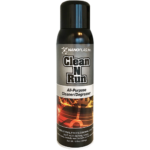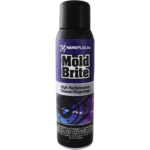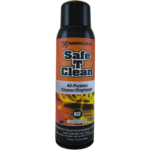Replacements and Solutions
The industrial cleaner and grease remover Trichlorethylene (TCE), also known as ethylene trichloride or trilene, has been banned by the Environmental Protection Agency (EPA) as a health hazard. Used for many years as a cleaner and degreaser, TCE has been found to be the cause of cancer and having negative effects on various organ systems due its inhalation. The stipulations from the EPA indicate that the sale of TCE ended on June 15 th , 2025, and its use must end by September 15th , 2025. In an effort to protect the community and our customers, the staff at Nanoplas are have removed our TCE product line and are recommending safer chemicals that perform the same work as TCE. In order to facilitate the switch from TCE, Nanoplas has prepared a list of reliable chemicals for cleaning and degreasing. EPA regulation 40 CFR 751 is a section of the code of federal regulations that outlines the regulation of chemicals, substances, and mixtures listed in Section 6 of the Toxic Substances Control Act (TSCA) of 1976. TCE has been added to the list after instances of its dangers became apparent. Companies and their products that have been affected by the EPA Regulation are:
- DAC Industries – DAC-205
- IMS Company – White 2000 and Non-Flammable Economy Mold Cleaner
- PPE/Plastic Processing Equipment – DMC-20
- Nanoplas – Power Clean – Off the Market as of June 16th , 2025
Due to the significance and the nature of the harm that TCE can do, Nanoplas is taking major steps to help our clients transition from TCE to other, viable products. Other organizations, in response to the EPA’s actions, are no longer offering degreasing solvents and have stopped manufacturing them. 3M and Novec have ceased production of their products. As more and more companies initiate their adherence to EPA standards, TCE will disappear as a degreaser and cleaner.
Selection Process For TCE Replacement
The necessity of replacing TCE initiates the process of choosing the proper solution that is people safe, planet safe, and economical. There are three factors that have to be considered when examining the alternatives to TCE, which are type of contamination, the substrate to be cleaned, and the location of the cleaning.
Contamination
Contamination refers to the material that is being cleaned, which can be flux paste or solder residue, materials that are found on circuit boards. Cleaners for such products are different than ones used to degrease metals. Lubricants, dust, metal particles, fingerprints, wax, and various other forms of residue have to be removed from metal parts before they can be sent on for further processing or being added to assemblies. In addition, cleaners are also used to prepare products for painting, plating, and welding. The type of material to be removed determines the cleaning fluid that will work best and not damage a product.
Substrate
A clear definition of the surface to be cleaned is important factor when choosing a cleaner. In modern manufacturing, there is a long list of products and the materials from which they are made. Plastics, ceramics, ferrous metals, non-ferrous metals, and on and on are all used to produce today’s high-quality products. The wrong solvent can damage the quality of a product and deter from its value. In essence, the fluid used to clean the substrate should be perfectly matched to the properties of the substrate. It is important that dirt, debris, and contaminates can be safely displaced without causing detrimental effects to the substrate or flash rusting.
Location
Although the EPA is the governmental agency that regulates industrial substances, local authorities may add to the EPA’s oversight with their own standards, since each state in the United States is unique in its climate, surroundings, and geography. Most companies are fully aware of local laws that govern the use of chemicals and strictly adhere to them. While the EPA is the governing body in the United States, Registration, Evaluation, Authorization, and Restriction of Chemicals (REACH) is the organization that oversees chemicals used in Europe. In California, Proposition 65, Safe Drinking Water and Toxic Enforcement Act of 1986, provides restrictions regarding chemical use in that state. When making the transition from TCE to other cleaners, it is essential to work with a manufacturer, such as Nanoplas, to use their expertise, experience, and know how in finding the right fit for your application. The use of informed sources who have worked with solvents and degreasers for many years can save time, money, and the laborious process of researching the different alternatives.
Steps in the Replacement Process
- Onsite Audit – An onsite audit helps a manufacturer understand the specific cleaning problem in order to select the proper replacement for TCE. Key factors are fluid density and viscosity requirements that influence the cleaning process.
- Replacement – Manufacturers, such as Nanoplas, provide a wide assortment of solutions that can fit the requirements of any application.
- Tested Solutions – As is typical of modern industrial operations, manufacturers of cleaners and degreasers provide data regarding the lab testing of their products to prove a products viability. In the case of degreasers and cleaners, test data provides an understanding of the chemical content of a product and the effects of the chemicals.
- On-Site Demonstrations – All manufacturers prove the quality of their products by demonstrating the effectiveness of a product in a real-world situation.
- Other Solutions – If a product proves to be inappropriate for an application, manufacturers work closely with their clients to find the perfect match to ensure the quality of a client’s products.
Solutions
After the EPA’s announcement, in 2024, like Nanoplas, other cleaning solvent companies have worked diligently to produce products that can replace ones that contain TCE. Although the effectiveness of each type of cleaner varies, each one provides the same cleaning power as TCE containing solvents. The variations between the degreasing solvents are in regard to how they are applied and their consistency.
Clean-N-Run
 Clean-N-Run, from Nanoplas, is a non-chlorinated mold cleaner and degreaser designed to remove contaminants from warm mold without leaving any residue. The controlled evaporation of Clean-N-Run enables users to invest more time in the cleaning process. A key feature of Clean-N-Run is its residue free formulation, which removes any concerns regarding after cleaning particulate matter or grease breakdown.
Clean-N-Run, from Nanoplas, is a non-chlorinated mold cleaner and degreaser designed to remove contaminants from warm mold without leaving any residue. The controlled evaporation of Clean-N-Run enables users to invest more time in the cleaning process. A key feature of Clean-N-Run is its residue free formulation, which removes any concerns regarding after cleaning particulate matter or grease breakdown.
Mold Brite
 Mold Brite, another Nanoplas cleaner, is an aggressive non-chlorinated cleaning agent that removes dirt, grease, and contaminants from metal surfaces. It quickly evaporates removing the need to use other materials to remove it from a surface or wipe it off. The efficiency of Mold Brite cleans surfaces down to the virgin metal and flushes contaminants from metal pores.
Mold Brite, another Nanoplas cleaner, is an aggressive non-chlorinated cleaning agent that removes dirt, grease, and contaminants from metal surfaces. It quickly evaporates removing the need to use other materials to remove it from a surface or wipe it off. The efficiency of Mold Brite cleans surfaces down to the virgin metal and flushes contaminants from metal pores.
Safe-T-Clean
 Safe-T-Clean is an NSF P1 listed, high performance cleaner and degreaser that has been declared safe for medical and food grade applications. It is a non-chlorinated cleaner that is far superior to all other non-chlorinated cleaners. The unique spray pattern of Safe-T-Clean breaks up tough material buildup and provides the ability to clean spots that are hard to reach where mold can buildup.
Safe-T-Clean is an NSF P1 listed, high performance cleaner and degreaser that has been declared safe for medical and food grade applications. It is a non-chlorinated cleaner that is far superior to all other non-chlorinated cleaners. The unique spray pattern of Safe-T-Clean breaks up tough material buildup and provides the ability to clean spots that are hard to reach where mold can buildup.
Conclusion
Concerns regarding TCE have motivated industrial leaders, such as Nanoplas, to produce non-toxic cleaners that can perform the same job that TCE did without harming workers and the environment. It is essential that all TCE users explore their alternatives regarding TCE and immediately initiate a process to find a replacement. It is Nanoplas goal and commitment to ensure the safety of our clients while providing superior and unequaled service. Although there is a wide selection of degreasers, solvents, and cleaners available, it is important to work with a qualified representative to choose the correct cleaner for the surface, particulate matter, and environment. The right choice ensures success and the protection of workers and equipment.
